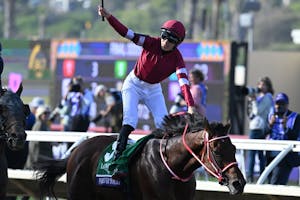Kentucky Derby Handicapping

TwinSpires logo
Yeah, yeah, yeah… I know. The Run for the Roses is still a month away, so why am I writing about Derby handicapping today? Well, it’s because I see the glass as half-full — the Kentucky Derby is just a month away! See the sense of urgency that creates? To my way of thinking, it would be downright irresponsible not to talk about Derby handicapping today.
As many regular readers know, I love talking S. H. I. T. about the Derby?
What is S. H. I. T. you ask?
It is Simon’s Historical Investment Technique, which is a fancy term for a point-based handicapping system designed to ferret out the winner of America’s biggest horse race. Now, I’ve got to be honest: my S. H. I. T. has stink, stunk, stank in recent years, so my confidence is at a low ebb as May 2 draws nearer. However, I’ve done some additional studies and truly believe that this year’s revamped S. H. I. T. is the biggest and best ever.
So, without further ado-do, let’s take a look at the rules:
- Award each horse the value of its most recent Brisnet speed figure (in points).
Rationale: Despite what some naysayers believe, speed matters. In fact, since 1999, horses that earned a Brisnet speed figure of 104 or greater in their final prep are 8-for-61 with a 60.7 percent ROI in Kentucky.
- +100 points if the horse finished in-the-money or was beaten by less than 5 lengths in its most recent race — provided it was run over today’s general surface (dirt or all-weather) and is less than 50 days old.
Rationale: No horse since Iron Liege in 1957 has managed to win the Derby following a poor showing in its final prep.
- +25 points if the steed’s best lifetime Brisnet speed figure was earned in one of its last two starts (less than 100 days ago).
Rationale: Since 1992 (the first year Beyer speed figures appeared in the Daily Racing Form), only one Derby winner — Sea Hero in 1992 — failed to earn its best career-to-date Beyer in one of its final three prep races.
- +25 points if horse’s last ESR ranks fourth or better in the field.
Rationale: Horses with a last-race ESR ranked among the top four in the field have produced a 9.1 percent ROI over the past 23 years.
- +25 points if horse’s last LSR ranks fourth or better in the field.
Rationale: Horses with a last-race LSR ranked among the top four in the field have produced a 21.4 percent ROI since 1992.
- -25 points if filly.
Rationale: Despite some decent performances by females in the Derby, as a group, they have underperformed in the Run for the Roses.
- -50 points if the horse’s last-race Brisnet speed figure was 10 points superior or inferior to its previous figure.
Rationale: To win the Derby, a horse needs to be at its absolute peak on the first Saturday in May. Wild speed figure fluctuations prior to the big race — remember Afleet Alex? —are rarely a good sign.
- -75 points if the horse went to post at odds of 15-1 or greater in its final prep.
Rationale: Since 1975, only two horses — Pleasant Colony in 1981 and Charismatic in 1999 — triumphed in Louisville after being overlooked in their final Derby tune-ups (both were 12-1).
- -100 points if the horse lost its last race after leading at the first call.
Rationale: As is true in most distance races, pure speed types are to be avoided in the Derby, especially when there are other early runners in the field (which is almost always the case).

ADVERTISEMENT


